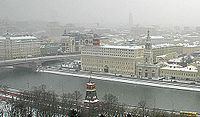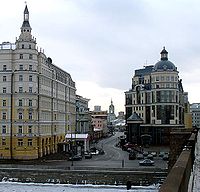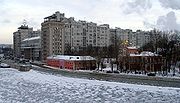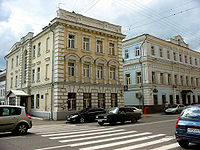
Balchug
Encyclopedia

Moscow
Moscow is the capital, the most populous city, and the most populous federal subject of Russia. The city is a major political, economic, cultural, scientific, religious, financial, educational, and transportation centre of Russia and the continent...
, Russia, squeezed between the Moskva River
Moskva River
The Moskva River is a river that flows through the Moscow and Smolensk Oblasts in Russia, and is a tributary of the Oka River.-Etymology:...
(just opposite the Kremlin) and its old river-bed which was turned into the Vodootvodny Canal
Vodootvodny Canal
Vodootvodny Canal is a 4 kilometre long, 30-60 metre wide canal in downtown Moscow, Russia. It was built in 1780s on the old riverbed of Moskva River to control floods and support shipping. Canal construction created an island between Moskva river and the canal. The island acquired its present...
in 1786. It is an integral part of historical Zamoskvorechye area; administratively, its territory belongs to Zamoskvorechye and Yakimanka
Yakimanka District
Yakimanka District is a district of Central Administrative Okrug of Moscow, Russia. Population: It is named after the former church of Saint Joachim and Saint Anne...
municipal districts.
In a strict sense, the name Balchug refers only to the short Balchug street, crossing the center point of the island parallel to Bolshoy Moskvoretsky Bridge
Bolshoy Moskvoretsky Bridge
Bolshoy Moskvoretsky Bridge is a concrete arch bridge that spans the Moskva River in Moscow, Russia, immediately east of the Moscow Kremlin. The bridge connects Red Square with Bolshaya Ordynka street in Zamoskvorechye. Built in 1936-1937, it was designed by V. S...
, and three city blocks around it. The island, like other islands on Moskva River, does not have an official name in Russian; rather, each neighborhood on the island is referred to with its own name. Unofficially it is known to Moscow residents as "Bolotny Ostrov" (Bog Island).
History, Balchug Street

Balchug is one of the oldest Moscow streets outside of the Kremlin walls. It emerged towards the end of the fourteenth century, when the new Kremlin built by Dmitri Donskoi
Dmitri Donskoi
Saint Dmitry Ivanovich Donskoy , or Dmitry of the Don, sometimes referred to as Dmitry I , son of Ivan II the Meek of Moscow , reigned as the Prince of Moscow from 1359 and Grand Prince of Vladimir from 1363 to his death. He was the first prince of Moscow to openly challenge Mongol authority in...
pushed the posad
Posad
A posad was a settlement, often surrounded by ramparts and a moat, adjoining a town or a kremlin, but outside of it, or adjoining a monastery in the 10th to 15th centuries. Usually it was inhabited by craftsmen and merchants, known as posadskiye lyudi .In the Russian Empire a posad was a small...
settlement into present-day Red Square
Red Square
Red Square is a city square in Moscow, Russia. The square separates the Kremlin, the former royal citadel and currently the official residence of the President of Russia, from a historic merchant quarter known as Kitai-gorod...
and further east. The main trading road to the south and the river crossing also moved to the east, to present-day Balchug and Pyatnitskaya streets. The name Balchug comes from Tatar
Tatar language
The Tatar language , or more specifically Kazan Tatar, is a Turkic language spoken by the Tatars of historical Kazan Khanate, including modern Tatarstan and Bashkiria...
balčyk, meaning 'dirt' or 'mud'. Muddy conditions in the area were caused by migrations of the river bed, frequent floods, and inadequate drainage.
In the fifteenth century, Prince Vasili I
Vasili I of Russia
Vasiliy I Dmitriyevich was Grand Prince of Moscow from 1389.He was the oldest son of Dmitri Donskoi and Grand Princess Eudoxia, daughter of Grand Prince Dmitry Konstantinovich of Nizhny Novgorod.-Domestic policy:...
set up royal gardens west of Balchug street (across from the Kremlin). The gardeners settled east of Balchug, giving its name to the Sadovniki neighborhood and present-day Sadovnicheskaya Street
Sadovnicheskaya Street
Sadovnicheskaya street is a street in the historical Zamoskvorechye District of Moscow, Russia, on a narrow island between Moskva River and the parallel old river bed . The street runs from Balchug Street south-east to the Garden Ring.-History:Historical neighborhood of Sadovniki Sadovnicheskaya...
. They set up flood control moats connecting River Moskva with the old river bed. Memories of those medieval moats - rovushki and endovy in Old Russian - survive in the names of Raushskaya Embankment and St. George Church "v Endove" (1653). One moat was just 50 meters east of Balchug street and survived until the 1850s.
Eventually, as the city grew south into Zamoskvorechye, Balchug became a market street. Tax records from 1669 counted 45 butchers, 28 bakers, 3 inns, public baths, and dozens of other businesses. In 1701, the Gardens and Balchug were swept by fire; another fire followed in 1730. The market reappeared each time, but in 1735 the government relocated the butchers beyond the city limits; by 1744 the market was selling mostly horses.
1783 flood destroyed most of Balchug and Sadovniki, including the St. George bell tower. By 1786, the city built the original Vodootvodny Canal, a flood control dike following the old river bed. The first metal bridge in Moscow, Chugunny Bridge (1830), connected Balchug with the Zamoskvorechye mainland. A steel bridge
Bolshoy Moskvoretsky Bridge
Bolshoy Moskvoretsky Bridge is a concrete arch bridge that spans the Moskva River in Moscow, Russia, immediately east of the Moscow Kremlin. The bridge connects Red Square with Bolshaya Ordynka street in Zamoskvorechye. Built in 1936-1937, it was designed by V. S...
north, to Red Square and Zaryadye
Zaryadye
Zaryadye is a historical district in Moscow established in 12-13th centuries within Kitai-gorod, between Varvarka Street and Moskva River. The name means "the place behind the rows", i.e., behind the market rows adjacent to the Red Square.-History:...
, was completed in 1872. Until the 1930s, Balchug remained a street of two-story shops; the only four-story building belonged to the Novomoskovskaya Hotel (now the Baltschug Kempinski Hotel).
Construction of the new Bolshoy Moskvoretsky Bridge
Bolshoy Moskvoretsky Bridge
Bolshoy Moskvoretsky Bridge is a concrete arch bridge that spans the Moskva River in Moscow, Russia, immediately east of the Moscow Kremlin. The bridge connects Red Square with Bolshaya Ordynka street in Zamoskvorechye. Built in 1936-1937, it was designed by V. S...
(1938) changed the street's status again. The main north-south artery moved west, bypassing Balchug. Houses between the bridge and Balchug street were razed (the northern end of this site remains vacant). What was left in the 1930s was destroyed in the 1990s. First, the old Balchug Hotel was built out from 4 to 9 stories high, then a Central Bank building replaced the few surviving buildings between the bridge and Balchug. One nineteenth-century single-story building remains as a facade curtain for a 9-story office block (see facadism
Facadism
Façadism is the practice of demolishing a building but leaving its facade intact for the purposes of building new structures in it or around it....
).
Vodootvodny Canal; Evolution of the island

Triumphal arch
A triumphal arch is a monumental structure in the shape of an archway with one or more arched passageways, often designed to span a road. In its simplest form a triumphal arch consists of two massive piers connected by an arch, crowned with a flat entablature or attic on which a statue might be...
, the first in Russia, was set up in wood in front of the bridge to welcome Peter I
Peter I of Russia
Peter the Great, Peter I or Pyotr Alexeyevich Romanov Dates indicated by the letters "O.S." are Old Style. All other dates in this article are New Style. ruled the Tsardom of Russia and later the Russian Empire from until his death, jointly ruling before 1696 with his half-brother, Ivan V...
's arrival from the Azov campaigns
Azov campaigns
Azov campaigns of 1695–96 , two Russian military campaigns during the Russo-Turkish War of 1686–1700, led by Peter the Great and aimed at capturing the Turkish fortress of Azov , which had been blocking Russia's access to the Azov Sea and the Black Sea...
. In 1783, the area was swept away by a severe flood which also damaged the bridge. In order to repair it, the Moskva River was temporarily drained, while its old riverbed was reconstructed into the four-kilometer-long Vodootvodny Canal
Vodootvodny Canal
Vodootvodny Canal is a 4 kilometre long, 30-60 metre wide canal in downtown Moscow, Russia. It was built in 1780s on the old riverbed of Moskva River to control floods and support shipping. Canal construction created an island between Moskva river and the canal. The island acquired its present...
(literally, 'Water Bypass Channel'), which is now spanned by ten bridges.
The first documented project was drawn in 1775, presumably by Matvey Kazakov
Matvey Kazakov
Matvey Fyodorovich Kazakov was a Russian Neoclassical architect. Kazakov was one of the most influential Muscovite architects during the reign of Catherine II, completing numerous private residences, two royal palaces, two hospitals, Moscow University, and the Kremlin Senate...
(senior). In addition to separating Balchug Island from Zamoskvorechye, Kazakov also proposed cutting two flood control dikes west from Bersenevka. This would separate strips of floodland from the mainland, creating two more islands. In the east, Kazakov planned to flood uninhabited farmland permanently and connect the Canal to Moskva River inside the present-day Garden Ring
Garden Ring
The Garden Ring, also known as the "B" Ring , is a circular avenue around the central Moscow, its course corresponding to what used to be the city ramparts surrounding Zemlyanoy Gorod in the 17th century....
. The eastern end of an island would become Moscow's grain port and warehouse. The moat east of Balchug had to be cleared and widened, too.
This plan materialized in 1783-1786, excluding the grain terminal. A 1807 plan shows only one additional island west of Bersenevka; otherwise, it follows Kazakov's project, with the main island cut into two halves by the Balchug moat.
Evolution of Vodootvodny Canal and the island
After the fire of 1812
Fire of Moscow (1812)
The 1812 Fire of Moscow broke out on September 14, 1812 in Moscow on the day when Russian troops and most residents abandoned the city and Napoleon's vanguard troops entered the city following the Battle of Borodino...
, the western island and the dike separating it from the mainland were reclaimed for development, and the Moskva River
Moskva River
The Moskva River is a river that flows through the Moscow and Smolensk Oblasts in Russia, and is a tributary of the Oka River.-Etymology:...
was reduced to about its present-day width (see the 1824 map). The eastern end of the Canal was also reduced to its ordinary width of 30 meters.
In 1835, the city built the Babyegorodskaya Dam west of the island. This enabled barge shipping in the Canal. A new channel extension east was built to bypass the old 90-degree turn; as the 1853 map shows, the new canal cut the Red Hills neighborhood away from the mainland. For a while, the island was cut into three parts, then, when the Balchug moat was filled, in two. The moat parallel to the Garden Ring
Garden Ring
The Garden Ring, also known as the "B" Ring , is a circular avenue around the central Moscow, its course corresponding to what used to be the city ramparts surrounding Zemlyanoy Gorod in the 17th century....
was filled in the 1930s, with the completion of the Bolshoy Krasnokholmsky Bridge
Bolshoy Krashokholmsky Bridge
Bolshoy Krasnokholmsky Bridge is a steel arch bridge that spans Moskva River in downtown Moscow, Russia, carrying Garden Ring between Tagansky District and Zamoskvorechye Districts. It was completed in 1938 by V.M.Vakhurkin , G.P.Golts and D.M.Sobolev...
.
Neighborhoods on the island
Four pairs of bridges (Bolshoy KamennyBolshoi Kamennyi Bridge
Bolshoy Kamenny Bridge is a steel arch bridge spanning Moskva River at the western end of the Moscow Kremlin. Its predecessor was the first permanent stone bridge in Moscow, Russia...
, Moskvoretsky
Bolshoy Moskvoretsky Bridge
Bolshoy Moskvoretsky Bridge is a concrete arch bridge that spans the Moskva River in Moscow, Russia, immediately east of the Moscow Kremlin. The bridge connects Red Square with Bolshaya Ordynka street in Zamoskvorechye. Built in 1936-1937, it was designed by V. S...
, Ustinsky
Bolshoy Ustinsky Bridge
Bolshoy Ustinsky Bridge is a steel arch bridge that spans Moskva River near the mouth of Yauza River, connecting the Boulevard Ring with Zamoskvorechye district in Moscow, Russia...
, Krasnokholmsky
Bolshoy Krashokholmsky Bridge
Bolshoy Krasnokholmsky Bridge is a steel arch bridge that spans Moskva River in downtown Moscow, Russia, carrying Garden Ring between Tagansky District and Zamoskvorechye Districts. It was completed in 1938 by V.M.Vakhurkin , G.P.Golts and D.M.Sobolev...
over the Moskva River and their lesser siblings over the Canal) cut the island into five distinct parts. In addition to the bridges listed above, the island is connected to the Zamoskvorechye mainland by two road and four pedestrian bridges over the Vodootvodny Canal; an extension of Patriarshy Bridge
Patriarshy Bridge
Patriarshy Bridge is a steel pedestrian arch bridge that spans Moskva River, connecting Cathedral of Christ the Saviour with Bersenevka in downtown Moscow, Russia . It was built in 2004, designed by Mikhail Posokhin...
is under construction, scheduled for completion at the end of 2007. The City announced plans to build a pedestrian bridge across the Moskva River
Moskva River
The Moskva River is a river that flows through the Moscow and Smolensk Oblasts in Russia, and is a tributary of the Oka River.-Etymology:...
in Red Hills, but no draft had been published as of 2007.
Bersenevka

House on Embankment
The House on the Embankment is a block-wide apartment house in downtown Moscow, Russia. It was completed in 1931 as the Government Building, a residence of Soviet elite...
, facing east, houses two theaters.
The city planners have been contemplating the conversion of Bersenevka industrial buildings into a high-scale hotel and condominium area. The work accelerated recently with the appointment of Guta Development to manage the project.
Boloto

Cossack
Cossacks are a group of predominantly East Slavic people who originally were members of democratic, semi-military communities in what is today Ukraine and Southern Russia inhabiting sparsely populated areas and islands in the lower Dnieper and Don basins and who played an important role in the...
rebels on .
Despite the unprepossessing name, Boloto was home to some of the finest mansions. One, owned by industrialist Gustav List, eventually became the British Embassy. In the 1890s, the city started a public housing experiment that led to the construction of block-wide apartment houses. One of these structures, directly facing the Kremlin, is now Rosneft
Rosneft
Rosneft is an integrated oil company majority owned by the Government of Russia. Rosneft is headquartered in Moscow’s Balchug district near the Kremlin, across the Moskva river...
headquarters. The city has far-reaching plans to rebuild the low-rise Boloto; as of 2007, they had not materialized. Many historical houses have been evacuated and have stood unattended for years. Ilya Repin Square, facing the Canal, contains Mikhail Chemiakin's controversial sculptures personifying human vices.
Sadovniki west or Balchug proper
The short stretch between Bolshoy Moskvoretsky BridgeBolshoy Moskvoretsky Bridge
Bolshoy Moskvoretsky Bridge is a concrete arch bridge that spans the Moskva River in Moscow, Russia, immediately east of the Moscow Kremlin. The bridge connects Red Square with Bolshaya Ordynka street in Zamoskvorechye. Built in 1936-1937, it was designed by V. S...
and Bolshoy Ustinsky Bridge
Bolshoy Ustinsky Bridge
Bolshoy Ustinsky Bridge is a steel arch bridge that spans Moskva River near the mouth of Yauza River, connecting the Boulevard Ring with Zamoskvorechye district in Moscow, Russia...
, including Balchug street and the beginning of Sadovnicheskaya Street
Sadovnicheskaya Street
Sadovnicheskaya street is a street in the historical Zamoskvorechye District of Moscow, Russia, on a narrow island between Moskva River and the parallel old river bed . The street runs from Balchug Street south-east to the Garden Ring.-History:Historical neighborhood of Sadovniki Sadovnicheskaya...
), is the most densely built part of the island. It houses Moscow's first electrical powerplant (still active); office space is traditionally occupied by electrical (Mosenergo
Mosenergo
Mosenergo is the Russian largest power generating company operating on fossil fuel and the world largest thermal generation company. In addition to electric power it also generates and sells heat for consumers in Moscow and the Moscow Oblast...
) and oil companies.
Sadovniki east

A mixed residential, educational, and industrial neighborhood centered around Sadovnicheskaya Street. Sadovniki east retained most of the traditional Zamoskvorechye air. The recent wave of development replaced the old textile mill with a block-sized office compound. Other than that, the 19th-century architecture remains remarkably well preserved. Sadovniki also possess two 1930s memorial buildings, the constructivist
Constructivist architecture
Constructivist architecture was a form of modern architecture that flourished in the Soviet Union in the 1920s and early 1930s. It combined advanced technology and engineering with an avowedly Communist social purpose. Although it was divided into several competing factions, the movement produced...
Textile Institute (1938) and postconstructivist
Postconstructivism
Postconstructivism was a transitional architectural style that existed in the Soviet Union in the 1930s, typical of early Stalinist architecture before World War II. The term postconstructivism was coined by Selim Khan-Magomedov, a historian of architecture, to describe the product of avant-garde...
School 518
School 518
School 518 is a high school in the historical Balchug area of Moscow, Russia. Designed by Ivan Zvezdin and completed in 1935, it is the only listed postconstructivist memorial building in the city...
, recently rebuilt to the original 1935 drafts and modern safety rules.
Red Hills
Prior to 1938 (construction of Bolshoy Krasnokholmsky BridgeBolshoy Krashokholmsky Bridge
Bolshoy Krasnokholmsky Bridge is a steel arch bridge that spans Moskva River in downtown Moscow, Russia, carrying Garden Ring between Tagansky District and Zamoskvorechye Districts. It was completed in 1938 by V.M.Vakhurkin , G.P.Golts and D.M.Sobolev...
, Red Hills was separated from the island by a narrow canal running just outside of the Garden Ring
Garden Ring
The Garden Ring, also known as the "B" Ring , is a circular avenue around the central Moscow, its course corresponding to what used to be the city ramparts surrounding Zemlyanoy Gorod in the 17th century....
(see 1853 map). As recently as 15 years ago, the eastern tip of the island was occupied by low-rise industrial property; this was torn down and gradually replaced by a compound of riverside offices, a hotel tower (2006), and the Moscow International House of Music
Moscow International House of Music
The Moscow International Performing Arts Center was officially opened on September 28, 2003 with the debut of a new orchestra, the National Philharmonic of Russia under musical director Vladimir Spivakov...
(2003).

